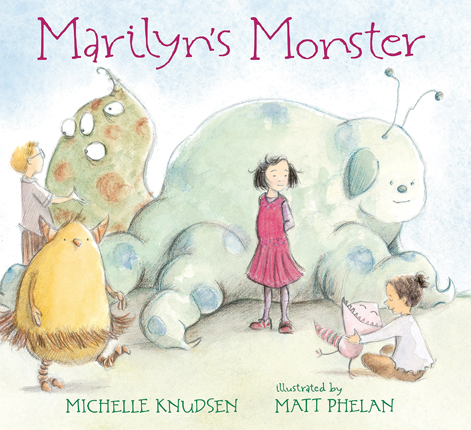| Marilyn's monster Author: Knudsen, Michelle | ||
| Price: $6.50 | ||
Summary:
A story about one little girl and the perfect monster she knows is out there ... and what happens when she decides she's waited long enough.
| Illustrator: | Phelan, Matt |
| Accelerated Reader Information: Interest Level: LG Reading Level: 3.30 Points: .5 Quiz: 173541 |
Reviews:
Kirkus Reviews (01/01/15)
School Library Journal (02/01/15)
Booklist (02/15/15)
The Bulletin of the Center for Children's Books (05/15)
Full Text Reviews:
Booklist - 02/15/2015 Marilyn’s friends are all lucky. They waited for their monsters to find them—during class; on the way home; once, fortuitously, while escaping bullies—just like they’re supposed to. But Marilyn remains monsterless. For a while, she was content to wait patiently for her monster and make sure she looked “very friendly and interesting and smart and fun to be around.” Soon, however, she gets fed up with waiting, so she heads out to find her monster on her own. At first, she still can’t find him, but finally her monster appears: he’s stuck in a tree branch and needs her help. Knudsen’s charming story is a great fit for Phelan’s gentle watercolor-and-pencil illustrations. With just a few lines and brushstrokes, he depicts the wide range of Marilyn’s emotions, from wary hopefulness to sullen grumpiness to, finally, utter joy. The whimsical, friendly monsters are equally expressive, and their supernatural antics in the background will tickle funny bones. Little ones feeling lonely or worried about making friends will be empowered by Marilyn’s determined, take-charge attitude. - Copyright 2015 Booklist.
School Library Journal - 02/01/2015 K-Gr 3—One of the poignancies of childhood is the waiting—for a loose tooth, to ride a bike, to learn to read. Knudsen's brilliantly simple narrative and Phelan's whimsical pencil and watercolor drawings speak to the universal need for belonging and the anxiety born of impatience. The story's opening sentence sets up the plot: "Some of the kids in Marilyn's class had monsters. It was the latest thing." These pet monsters each seek out just the right child, and that takes time, so at first Marilyn isn't worried about not having one of her own. But the longer she waits the less patient she is; she adjusts her appearance and behavior hoping to attract it and then tries to convince herself that having one doesn't matter anyway. "But they were pretty great. She could see that they were…." So finally, against the advice of her know-it-all older brother (his monster sits on his head like a squishy baseball hat), Marilyn takes matters in her own hands. She packs a lunch and sets out to find her monster—which happens to have gotten stuck in a tree while trying to find her. Every one of Phelan's monsters is wonderfully weird, and readers will have fun noting similarities between them and their human friends. VERDICT Pair this story with Mo Willems's Leonardo, the Terrible Monster (Hyperion, 2005) and Ed Emberley's Drawing Book of Weirdos (Little, Brown, 2002) for a ready-made guidance lesson or a fun storytime with built-in text-to-self connections.—Lisa Lehmuller, East Providence School District, RI - Copyright 2015 Publishers Weekly, Library Journal and/or School Library Journal used with permission.
Bulletin for the Center... - 05/01/2015 “Some of the kids in Marilyn’s class had monsters. It was the latest thing.” But monsters, in young Marilyn’s world, can’t be bought or sought out-kids must wait until their monster finds them, and Marilyn’s is a long time coming. She therefore spiritedly decides to go looking for it, and after much searching she does in fact find her monster (it got lost and its wings got it stuck in a tree), to the relief and delight of both the monster and Marilyn. This is an intriguing and offbeat story, and Knudsen’s matter-of-fact narration effectively draws readers into the situation, while subtly engaging kids at their emotional core-who hasn’t felt left out of a group, or lonely at night? Who doesn’t want to be chosen and acknowledged by someone special? Marilyn’s determination and proactive response to her monsterless state also provide children with a useful, non-preachy model. Phelan’s soft-edged watercolor and pencil art and his rendering of the monsters as mostly nonthreatening, friendly beasts keep their actions comforting rather than creepy. Dark-haired Marilyn is a physically expressive figure in her longing, frustration, and, finally, joyfulness, and her gentle-faced, shaggy green monster with golden wings and horns is clearly a perfect match for her in both size and temperament. This would make a thoughtful complement to Santat’s The Adventures of Beekle (BCCB 6/14) or an imaginative prompt for a creative writing or art project; it could also inspire some interesting group discussion. JH - Copyright 2015 The Board of Trustees of the University of Illinois.



